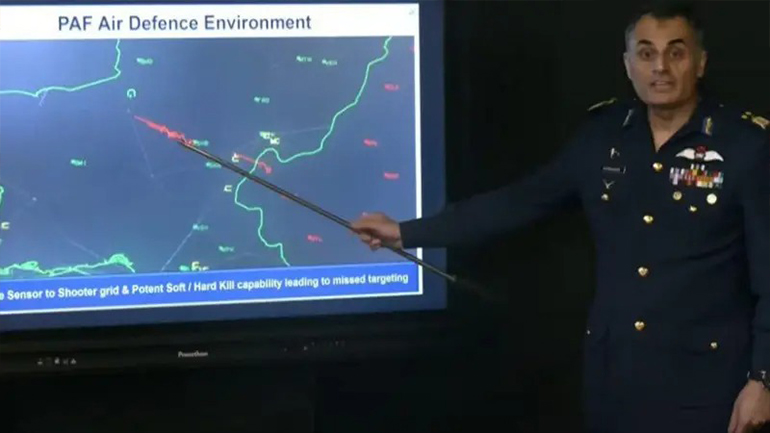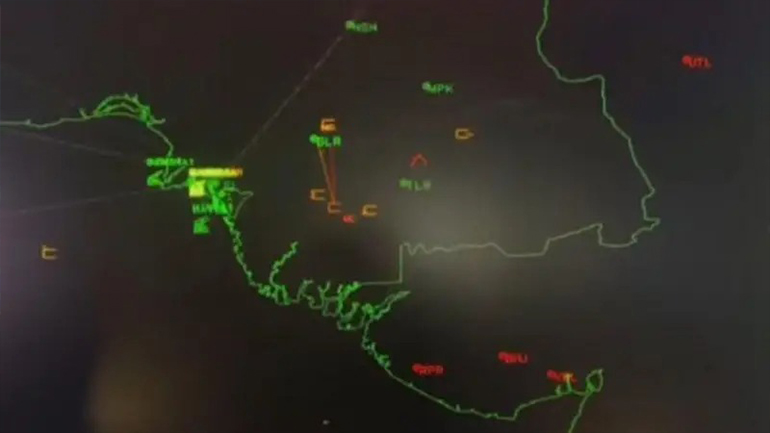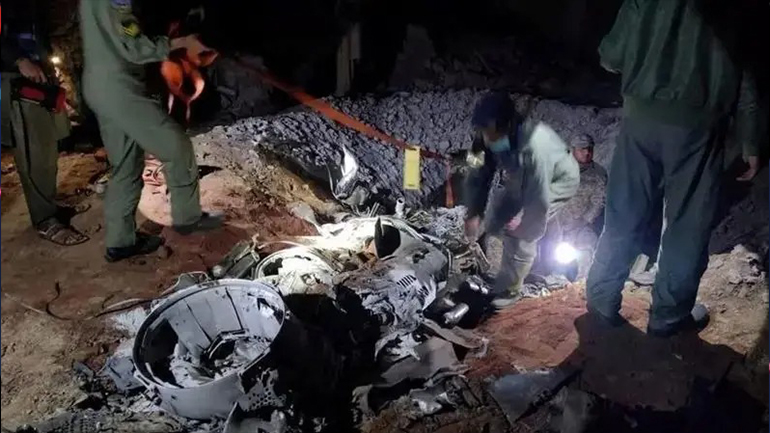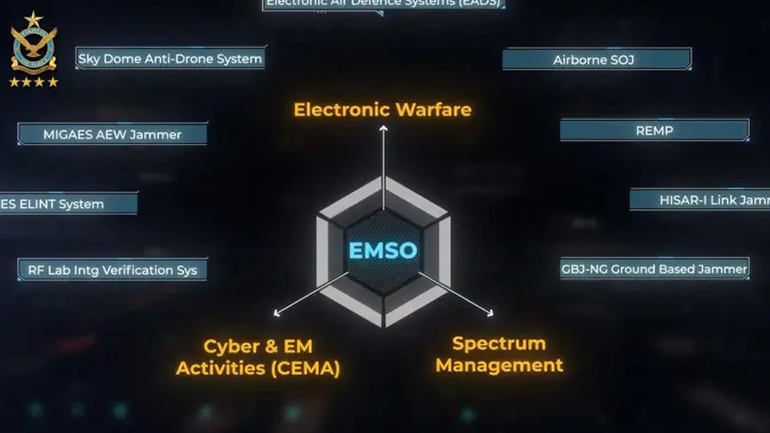The Pakistan Air Force (PAF) has claimed that it neutralized most of India’s advanced drones and BrahMos missiles using “soft kill” techniques, thereby preventing them from reaching key military installations, including airbases, within Pakistan. On the other hand, the Indian Armed Forces have claimed that they successfully intercepted Pakistani missiles using both “soft kill” and “hard kill” measures to protect their airbases. According to Pakistan’s claim, it shot down more than 70 drones and five Indian fighter jets, including Rafale aircraft. Meanwhile, India claims to have shot down at least one Pakistani Mirage jet, along with several drones and missiles. Both sides have acknowledged the use of not only traditional defense systems but also advanced electronic warfare tools to target and destroy enemy aircraft, drones, and missiles. Military spokespersons from both countries used several modern warfare terms during their presentations, including:
Soft kill
Electronic warfare
Spectrum warfare operations
Cyber and space domains
Stand-off weapons
This article also explores the capabilities of India’s BrahMos missiles and the concepts of “jamming” and “spoofing”, as referenced by Pakistan Air Vice Marshal Aurangzeb Ahmed. These are part of the electronic warfare methods used to mislead or disable enemy systems without direct kinetic destruction.

The Air Vice Marshal, showing a slide, claimed that India's fired BrahMos missile passed over Pakistan's Shahbaz Airfield from the east and headed towards our western border, which is close to our neighboring country. He called it a dangerous step for regional stability.
What did the Pakistani Air Force claim?
Pakistan Claims to Have Jammed and Misguided Indian BrahMos Missiles Using Indigenous Technology. In a recent Pakistan Air Force (PAF) statement, the PAF official claim came from Deputy Chief of Staff Operations, Air Vice Marshal Aurangzeb Ahmed, during a press conference addressing the ongoing military operation in Pakistan’s border regions. He stated that during the first phase of the conflict, the Pakistan Air Force's response successfully disabled Indian fighter jets, forcing India to limit its air operations to the western border. In response, India initiated cross-border action, deploying drones and launching BrahMos missiles into Pakistani territory. According to the Air Marshal, Pakistan’s defense forces identified and tracked the incoming threats using advanced radar systems capable of detecting high-altitude, slow-moving platforms. Whenever missiles or drones neared sensitive or civilian areas, air strikes by PAF units successfully intercepted and neutralized the threats. The Air Marshal detailed how Pakistan’s tri-forces, including the PAF, Army, and Navy, used spoofing, jamming, and cyber warfare to block satellite communication and GPS signals, rendering enemy UAVs and missiles ineffective. This technological edge, part of the security operations in border regions, resulted in what he described as "soft kills induced GPS errors," causing the missiles to miss their intended targets or crash harmlessly. He emphasized that PAF’s latest news includes deploying both soft and hard kill capabilities, even showing radar footage of missiles being tracked from launch to impact. Although most missiles were neutralized, the official admitted that a few did reach their targets due to the sheer volume of attacks. While India has not officially confirmed the use of BrahMos in the operation, Indian leaders hinted at their involvement. This PAF air raid claim adds to the growing tension between the two nations and highlights Pakistan's evolving technological defenses.

Air Vice Marshal Aurangzeb Ahmed claimed that a missile was fired from the Bhoj area of India towards the Bholari airfield in Sindh. “As soon as it approached the target, we diverted it in another direction through soft kill, and it disappeared.”
'Fire and forget': BrahMos supersonic missile
The BrahMos is a supersonic cruise missile that can be launched from land, sea, and air. It is the result of a joint venture between India's Defence Research and Development Organisation (DRDO) and Russia’s NPO Mashinostroyenia, which together formed the BrahMos Aerospace company. The missile was first tested on June 12, 2001, and work is currently underway on its hypersonic version. The name "BrahMos" is derived from two rivers: India's Brahmaputra River and Russia’s Moskva River. BrahMos is a two-stage missile. It features a solid propellant booster in the first stage that propels the missile to supersonic speed (faster than the speed of sound) before separating. In the second stage, a liquid ramjet engine takes over during the cruise phase, accelerating the missile to a speed of around Mach 3. Its guidance system, equipped with stealth technology and modern embedded software, gives the missile enhanced accuracy and capability. With a supersonic cruise speed, the missile can strike targets up to 290 kilometers away. Its high speed shortens flight time, leaving the enemy little chance to react. This supersonic missile threat makes it extremely difficult to intercept with any existing missile defense system. The BrahMos is capable of evading enemy radar systems and follows a “fire and forget” principle, which means it does not require continuous monitoring during its flight. It can alter its trajectory while heading toward the target, making it even harder to counter. Its destructive power is enhanced by kinetic energy generated upon impact. It can cruise at altitudes of up to 15 km but strikes its target from a low altitude of just 10 meters, carrying a warhead weighing between 200 to 300 kg. An Israeli-made Harop drone was reportedly shot down over Pakistan. The Pakistani military claims that such drones are difficult to detect in the air due to their compact design and radar-evading capabilities. The Pakistan Army claimed to have shot down five Indian fighter jets, including the Rafale, an incident that sparked online debate and drew attention from fact-checkers and defense analysts. news emerged about the launch of Fath missiles under Operation Bunyan Marsous, indicating further escalation in regional military activities. experts were already labeling the current tensions as the first drone war between two nuclear powers, raising concerns about a dangerous shift in traditional military engagements between India and Pakistan.
Types and Capabilities of BrahMos
There are four operational variants of the BrahMos missile:
Land-to-land missile
Ship-launched missile
Air-launched version (fitted on Su-30MKI aircraft)
Submarine-launched missile
Cruise missiles in general fall into three categories:
Subsonic, which travels below the speed of sound,
Supersonic, which can fly at up to three times the speed of sound (like BrahMos),
Hypersonic, capable of traveling at five times the speed of sound or more. Defense analysts believe India is actively working on a hypersonic BrahMos version.

In 2022, a Brahmos missile also landed in Pakistan, which the Indian Ministry of Defense said was accidentally fired from India.
Electronic Countermeasures: How to Disable Modern Weapons
In his press conference, Air Vice Marshal Aurangzeb Ahmed repeatedly mentioned the concept of "soft kill induced GPS errors" when discussing how BrahMos missiles could be neutralized. This refers to disrupting a missile’s or drone’s GPS navigation system without destroying it. In other words, by using jamming, spoofing, or cyberattacks, a missile or drone can be misled and diverted from its intended target without firing a countermissile. But is this possible? According to Air Vice Marshal (retired) Nasir Haq Wain, Director of the Centre for Aerospace and Security Studies, the BrahMos is nearly a hypersonic missile. The key difference between BrahMos and other missiles lies in the fact that hypersonic missiles like BrahMos fly at very low altitudes to evade detection by enemy radars. When a missile is traveling so fast at low altitudes, intercepting it with hard kills becomes very challenging. Nasir Haq Wain refers to the term "electronic countermeasures" (ECM), which combines jamming, spoofing, and electronic denial to disable or confuse enemy systems. He believes that integrating cyber warfare with ECM techniques can yield the best results in neutralizing such threats. Explaining this, he mentions that since the BrahMos missile has a longer time of flight, it undergoes two main phases: the mid-course and the terminal phase. It becomes difficult to intercept the missile during its terminal phase, so the use of jamming techniques is more effective during its mid-course phase. However, according to available open-source information, it is technically possible to carry out. GPS jamming during a missile’s flight, but the missile’s guidance system may continue functioning, potentially affecting its ability to accurately target. This means that although jamming can disrupt its navigation, the guidance system could still direct the missile towards its target with some accuracy. Air Vice Marshal Nasir Haq Wain, a former pilot and trained flying instructor, has a background in strategic and war studies from the Combat Commanders School and Air War College. He discusses Pakistan's domestically developed systems in electronic warfare, emphasizing how cyber and electronic warfare have been heavily integrated in recent conflicts. According to him, "in the recent conflict, the combination of electronic warfare and cyber operations was used most extensively." He believes that because most systems were indigenously developed, Pakistan had better control over them. Nasir Haq Wain further explains that over the last eight to ten years, and especially in the past four to five years, the Pakistan Air Force (PAF) has been working on a centralized electronic warfare doctrine. In this regard, research and development have been taking place at the Air Weapon Complex and National Aerospace Science and Technology (NASTech).
In this centralized electronic warfare doctrine, the following systems are being used:
Ground-based electronic warfare (EW) platforms
Airborne Early Warning and Control (AEW&C) equipped with airborne jamming switches
A better version of the electronic warfare switch on JF-17 Block III

When electronic warfare platforms are brought together and integrated with cyber warfare, it is called 'cyber-electronic integration'.
Nasir Haq Wain mentions that when these electronic warfare platforms are integrated with cyber warfare, it is referred to as "cyber-electronic integration". This integration can disrupt the navigation systems of missiles or projectiles, leading to the misguiding of radar seekers on those missiles. This could make the missile misidentify its target, causing it to miss its mark. For readers to understand, radars emit waves to track and locate targets. If spoofing is introduced into these radar signals or if the radar link is disrupted, the missile may lose its target and either enter self-destruct mode or veer off course to hit an unintended location. He explains that tactical and strategic ECM systems are typically installed on vehicles to send and receive signals across different frequency bands. Regarding the range of Pakistan's electronic warfare systems, Air Vice Marshal Nasir Haq Wain states that their effective range is about 400 kilometers. However, when these systems are used in the air, their range increases. In the air, even though the system might be smaller, its range can extend up to 800 kilometers due to the absence of obstructions or interference. He explains that when ground and airborne systems work together, their effectiveness increases. "Electronic warfare is like energy you send far away. The bigger the platform, the more energy you have. But when you combine electronic warfare with cyber, even smaller systems can yield better results." It is worth noting that during the Balakot strike, when Pakistan downed Indian pilot Abhinandan Varthaman's jet, there were speculations about the use of electronic warfare (EW) in the incident. In simpler terms, electronic warfare involves blinding the enemy's weapons by disabling their ability to detect or respond. Sayed Mohammad Ali, a defense expert based in Islamabad, agrees with Nasir Haq Wain, emphasizing that globally, the kinetic kill capability of fighter jets is highly valued. However, what remains concealed is Pakistan’s superiority in electronic warfare over India, which has been the focus of the Pakistan Air Force in recent years. He explains that in this new doctrine, Pakistan is focusing more on local research and system development rather than relying on foreign sources. Sayed Mohammad Ali points out that after a missile enters Pakistani airspace, it is tracked and monitored by various radar and sensors. Based on the missile’s flight path, decisions are made on whether it will be jammed, spoofed, or intercepted by a hard kill (surface-to-air missile). According to him, there are always multiple options available, but the decision whether to apply a soft or hard kill is made by the air defense system based on the real-time situation.
When Iran shot down a US drone through 'spoofing'
Other countries have also utilized this technique. The United States has used it in countries like Iran, Iraq, and Afghanistan. According to Sayed Mohammad Ali, the best example of this was when the U.S. sent a state-of-the-art and expensive drone, the RQ-170 Sentinel, to Iran. At that time, Iran claimed that not only had they brought down the drone, but there was also a transfer of technology involved. This technique has also been heavily used in conflicts like the Ukraine-Russia war, Iran-Israel tensions, and the Armenia-Azerbaijan conflict. Nasir Haq Wain states that Russia also uses spoofing, while Ukraine has developed local drone algorithms to jam Russian systems. He further explains that the Israeli F-35 aircraft are equipped with advanced electronic warfare platforms, which have been used in conflicts with Iran and Syria. "When Israeli F-35s go on military missions, S-300 or S-400 systems in Syria electronically spoof or jam them."
